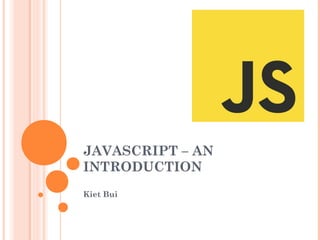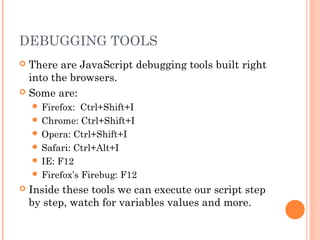JavaScript is a scripting language used to make web pages interactive. It was created in 1995 and standardized as ECMAScript. JavaScript can access and modify the content, structure, and style of documents. It is used to handle events, perform animations, and interact with forms on web pages. Common uses of JavaScript include form validation, navigation menus, lightboxes, and sliders on websites.



![: THE THREE LAYERS OF THE WEB
HTML for Content
<p class=“warning”>There is no <em>download
link</em> on this page.</p>
CSS for Presentation
.warning { color: red; }
JavaScript for Behavior
<script type=“text/javascript”>
window.alert(document.getElementsByClassName(“
warning”)[0].innerHTML);
</script>](https://image.slidesharecdn.com/javascript-141127001142-conversion-gate01-160423155735/85/JavaScript-Tutorial-4-320.jpg)






![ARRAYS
Arrays: To hold a collection of items together.
Can store any data types together in single
array.
i.e., var array = [1, {“k”: “v”}, 2.3, [“another”,
“array”]];
2 types: Single dimensional and Multi
dimensional (array of array(s)).
i.e., var array = [“1st”, “2nd”, “3rd”];
var arrayM = [[“1st”], [“2nd”], [“3rd”]];
Accessing values stored in array: We use what is
called index which is some integer ranges from 0
to array’s length - 1.](https://image.slidesharecdn.com/javascript-141127001142-conversion-gate01-160423155735/85/JavaScript-Tutorial-11-320.jpg)
![ACCESSING ARRAYS
Accessing Single dimensional array:
i.e., array[0]; // 1st
array[1]; // 2nd
array[2]; // You guess here.
Accessing Multi dimensional array:
i.e., arrayM[0]; // [“1st”]
arrayM[0][0]; // 1st.](https://image.slidesharecdn.com/javascript-141127001142-conversion-gate01-160423155735/85/JavaScript-Tutorial-12-320.jpg)
![ASSOCIATIVE ARRAYS
Associative Arrays: Kind of Java Maps.
Remember the Key-Value pairs?
i.e., var pincodes = [];
pincodes[“khanpur”] = 110062;
pincodes[“badarpur”] = 110044;
pincodes[“saket”] = 110017;
Accessing Associative arrays:
i.e., pincodes[“saket”]; // 110017
pincodes[“badarpur”]; // You guess here.
Associative arrays are actually Objects!](https://image.slidesharecdn.com/javascript-141127001142-conversion-gate01-160423155735/85/JavaScript-Tutorial-13-320.jpg)







![A SECRET ARRAY
arguments array: Functions have one secret.
They contain the arguments array. This array
contains all the arguments passed to the
function.
i.e., function poll() {
var affirmative = arguments[0];
var negative = arguments[1];
}
// Calling the function
poll(“affirmative”, “negative”);](https://image.slidesharecdn.com/javascript-141127001142-conversion-gate01-160423155735/85/JavaScript-Tutorial-21-320.jpg)







![: DOCUMENT ACCESS
Document Object Model: Mapping your HTML.
The browser stores its interpreted HTML code as
a structure of JavaScript objects, called DOM.
DOM consists of Nodes. There are currently 12
types of nodes. Most of which we use are
ELEMENT_NODE (1), ATTRIBUTE_NODE
(2), TEXT_NODE (3).
We can use the nodeType property to check the
type of the node. i.e.,
document.getElementsByTagName(“h1”)
[0].nodeType; // 1](https://image.slidesharecdn.com/javascript-141127001142-conversion-gate01-160423155735/85/JavaScript-Tutorial-29-320.jpg)



![ Altering style: We can use the style property to
alter the style of any element. i.e.,
document.getElementsByTagName (“body”)
[0].style.background = “#ddd”;
document.getElementByTagName(“label”)
[0].style.position = “absolute”;
document.getElementByTagName(“label”)
[0].style.left = “300px”;
We can also use className property to access or
set a CSS class directly. It’s directly available on
the element.
MANIPLUATING STYLE AND
CLASSES](https://image.slidesharecdn.com/javascript-141127001142-conversion-gate01-160423155735/85/JavaScript-Tutorial-33-320.jpg)































